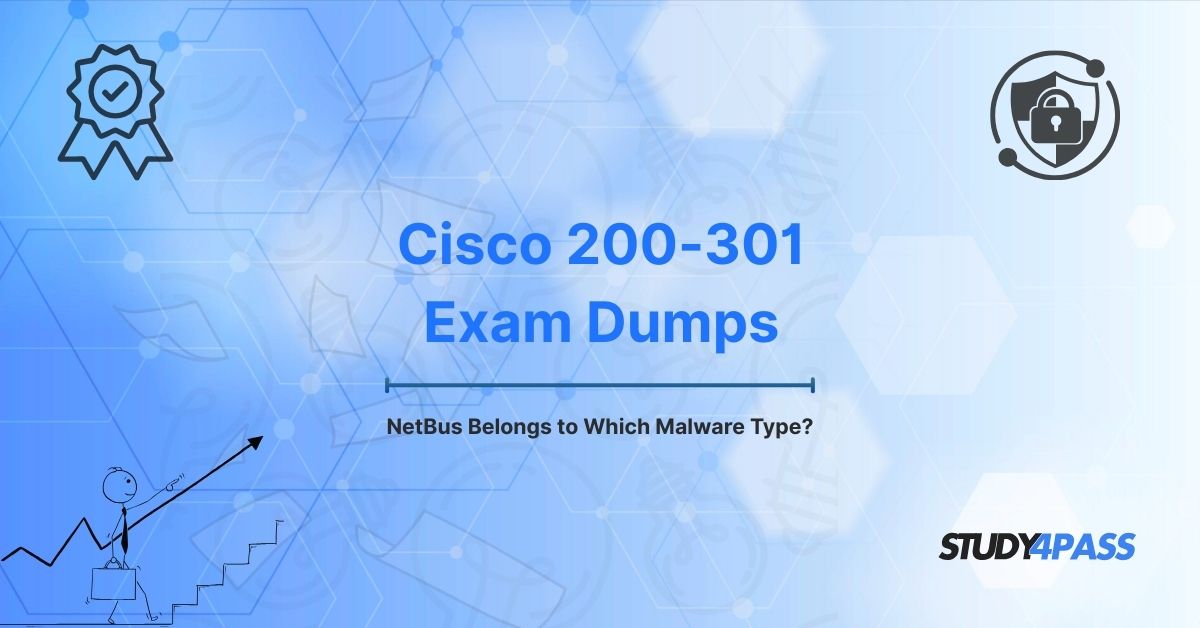Introduction
In the ever-evolving landscape of cybersecurity, understanding the nature of malware is crucial for professionals aiming to protect networks and systems. NetBus, a notorious piece of malicious software, serves as a prime example of a cyberthreat that has shaped the study of network security. This article explores NetBus, its classification as a malware type, and its implications for network support and security. Furthermore, it connects these concepts to broader cybersecurity threats, essentials, and the relevance of certifications like Cisco 200-301 (CCNA) and Cisco 200-201 (CBROPS). For students and professionals preparing for these certifications, platforms like Study4Pass offer invaluable resources to master these topics efficiently.
NetBus: An Overview
NetBus, first discovered in the late 1990s, is a remote administration tool (RAT) that gained infamy for its malicious applications. Originally designed for legitimate remote control of systems, it was quickly exploited by cybercriminals to gain unauthorized access to victims' computers. NetBus allowed attackers to perform actions such as capturing keystrokes, accessing files, and even controlling the victim's webcam or microphone—all without the user's knowledge.
Its stealthy nature and ability to bypass early antivirus defenses made NetBus a significant threat in its time. While modern malware has evolved, NetBus remains a critical case study for understanding remote access vulnerabilities and the importance of robust cybersecurity measures.
Malware Classification: Where Does NetBus Belong?
Malware is broadly categorized into several types, including viruses, worms, ransomware, spyware, adware, and trojans. Each type has distinct characteristics and methods of infection. To determine where NetBus fits, we must analyze its behavior and infection mechanisms.
NetBus does not self-replicate like a worm or encrypt files like ransomware. Instead, it disguises itself as a legitimate program to trick users into installing it, after which it provides attackers with backdoor access to the system. This behavior aligns with the characteristics of a trojan horse, making it a classic example of this malware category.
NetBus as a Trojan Horse
A trojan horse, named after the Greek myth, masquerades as harmless software to deceive users. Once executed, it delivers a malicious payload. NetBus fits this profile perfectly. It often arrived disguised as an innocuous file, such as a game or utility, enticing users to run it. Upon execution, NetBus installed itself silently, opening a backdoor for attackers to exploit.
Unlike viruses that spread automatically, trojans like NetBus rely on social engineering to propagate. This reliance on human error underscores the importance of user education and vigilance in cybersecurity, topics heavily emphasized in certifications like Cisco 200-201.
Network Support and Security Considerations
From a network support perspective, NetBus highlights the critical need for monitoring and securing network traffic. Since it communicates with a remote attacker, NetBus generates suspicious network activity, such as unusual outbound connections or unauthorized port usage. Network administrators must employ tools like intrusion detection systems (IDS) and firewalls to detect and block such anomalies.
Moreover, NetBus exploits vulnerabilities in unpatched systems, emphasizing the importance of regular updates and patch management. For professionals studying for Cisco 200-301, understanding these principles is essential, as the CCNA exam covers network security fundamentals, including access control and threat mitigation.
Cybersecurity Threats: Broader Context
NetBus is just one piece of the broader cybersecurity threat landscape. Today, organizations face advanced persistent threats (APTs), phishing campaigns, ransomware, and distributed denial-of-service (DDoS) attacks. While NetBus represents an older form of malware, its tactics—such as exploiting trust and leveraging remote access—are still relevant.
Modern threats often combine multiple malware types. For example, a trojan like NetBus could serve as an entry point for ransomware or spyware. This interconnectedness underscores the need for a holistic approach to cybersecurity, encompassing endpoint protection, network monitoring, and threat intelligence.
Cybersecurity Essentials
At its core, cybersecurity is about protecting confidentiality, integrity, and availability (CIA triad). NetBus violates all three:
- Confidentiality: By capturing keystrokes and accessing files, it compromises sensitive data.
- Integrity: It alters system settings to maintain persistence, undermining trust in the system.
- Availability: It can disrupt system performance or enable further attacks that deny access.
To counter such threats, cybersecurity essentials include strong passwords, multi-factor authentication (MFA), regular backups, and employee training. These principles are foundational for certifications like Cisco 200-201, which focuses on security operations and incident response.
Cisco Certification Relevance
Cisco certifications like 200-301 and 200-201 are designed to equip professionals with the skills to tackle real-world cybersecurity challenges. The Cisco 200-301 (CCNA) provides a broad foundation in networking, including security fundamentals, network access, and IP services. Understanding malware like NetBus helps CCNA candidates grasp the importance of securing network devices and implementing access controls.
The Cisco 200-201 (CBROPS) delves deeper into cybersecurity operations, covering threat analysis, incident response, and security monitoring. NetBus serves as a practical example for CBROPS candidates, illustrating how trojans operate and how to detect them using tools like Security Information and Event Management (SIEM) systems.
Preparing for these exams requires comprehensive study materials and practice. Platforms like Study4Pass offer tailored resources, including practice questions, study guides, and exam simulations, to help candidates succeed. By focusing on real-world scenarios like NetBus, Study4Pass ensures learners are well-prepared for both certification exams and practical challenges.
Conclusion
NetBus, as a trojan horse, serves as a timeless reminder of the dangers lurking in cyberspace. Its ability to deceive users and compromise systems underscores the need for robust network support, vigilant security practices, and a deep understanding of cybersecurity essentials. For those pursuing Cisco certifications like 200-301 and 200-201, studying malware like NetBus provides critical insights into threat mitigation and network protection.
Platforms like Study4Pass play a pivotal role in this journey, offering high-quality resources to master complex topics and excel in certification exams. By leveraging such tools, aspiring cybersecurity professionals can build the expertise needed to safeguard networks against threats old and new, ensuring a secure digital future.
Special Discount: Offer Valid For Limited Time “Cisco 200-301 CCNA”
Actual Exam Question from Cisco Certification
NetBus Belongs to Which Malware Type?
A) Virus
B) Worm
C) Trojan Horse
D) Ransomware


